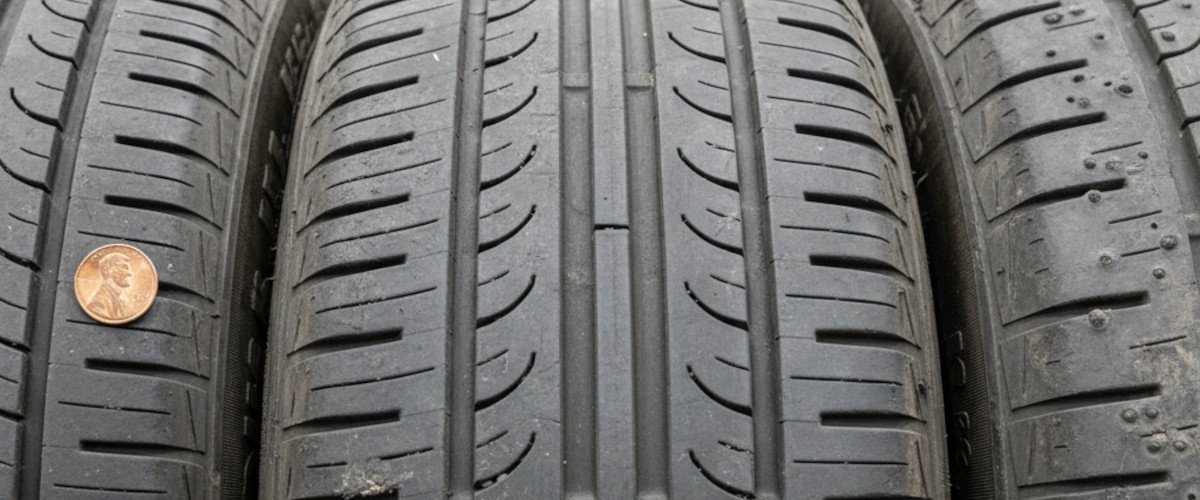| QuickStop Tire

Knowing when to replace your tires is crucial for your safety and the safety of others on the road. Worn or damaged tires can significantly impact your vehicle's handling, braking, and overall performance, especially in Ottawa's challenging weather conditions. Here are the key warning signs that indicate it's time for new tires.
Tread Depth Indicators
The most important factor in determining tire replacement is tread depth. When tread depth reaches 2/32 of an inch (1.6mm), tires are considered legally worn out and unsafe for driving. However, for optimal safety, especially in wet conditions common in Ottawa, consider replacing tires when they reach 4/32 of an inch (3.2mm).
The Penny Test
One of the easiest ways to check tread depth is the penny test. Insert a penny into the tread groove with Lincoln's head facing down. If you can see the top of Lincoln's head, your tread is too shallow and it's time for new tires. For better safety in wet conditions, use a quarter instead - if you can see the top of Washington's head, consider replacement.
Visible Wear Indicators
Modern tires have built-in wear indicators (TWI - Tread Wear Indicators) that appear as raised bars across the tread grooves. When these bars become flush with the tread surface, the tire has reached its minimum safe depth and should be replaced immediately. These indicators are located at multiple points around the tire circumference.
Uneven Wear Patterns
Uneven wear can indicate various problems and may require tire replacement:
- Center Wear: Overinflation causes excessive wear in the center of the tread
- Edge Wear: Underinflation causes wear on both outer edges
- One-Side Wear: Alignment issues cause wear on one side of the tire
- Cupping or Scalloping: Irregular wear patterns indicating suspension or balance problems
Cracks and Dry Rot
Age-related deterioration can cause tires to develop cracks in the sidewall or tread area. This dry rot occurs due to exposure to UV rays, ozone, and extreme temperature changes. If you notice small cracks or the rubber appears brittle, the tire's structural integrity may be compromised and replacement is necessary.
Bulges and Blisters
Bulges or blisters on the tire sidewall indicate internal damage to the tire's structure. These can be caused by impact damage, manufacturing defects, or internal separation. Any visible bulge or blister is a serious safety concern and requires immediate tire replacement.
Age-Related Replacement
Even with adequate tread depth, tires should be replaced based on age. Most manufacturers recommend replacing tires after 6-10 years, regardless of tread wear. Check the tire's DOT (Department of Transportation) code to determine the manufacturing date. The last four digits indicate the week and year of manufacture.
Performance Issues
Noticeable changes in your vehicle's performance can indicate tire problems:
- Poor Traction: Slipping or sliding in wet conditions
- Vibration: Steering wheel or seat vibration at highway speeds
- Noise: Excessive road noise or humming sounds
- Handling Issues: Vehicle pulling to one side or poor cornering
Frequent Pressure Loss
If you find yourself adding air to your tires more frequently than usual, it could indicate a slow leak or structural damage. While some pressure loss is normal, excessive or rapid pressure loss requires professional inspection and may necessitate tire replacement.
Impact Damage
Hitting potholes, curbs, or road debris can cause internal damage that's not immediately visible. If you've experienced a significant impact, have your tires inspected by a professional. Internal damage can lead to sudden tire failure, especially dangerous at high speeds.
Seasonal Considerations for Ottawa
Ottawa's harsh winters and variable weather conditions make tire condition even more critical. Winter tires should be replaced when they reach 6/32 of an inch (4.8mm) for optimal snow and ice performance. Summer tires should have adequate tread depth for handling spring and fall rain conditions.
Professional Inspection
Regular professional inspections can catch tire problems before they become safety hazards. At QuickStop Tire Ottawa, our experienced technicians can assess your tire condition, identify potential issues, and recommend appropriate replacement timing. We also provide detailed explanations of any problems found and their implications for your safety.
Don't wait for a tire failure to address replacement needs. Regular monitoring of these warning signs and proactive replacement when necessary ensures your safety and the safety of others on Ottawa's roads. When in doubt, consult with our tire experts at QuickStop Tire Ottawa for professional assessment and recommendations.






